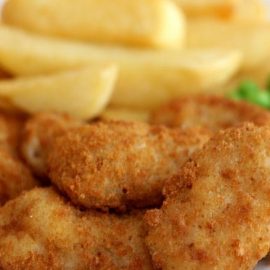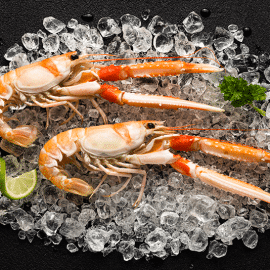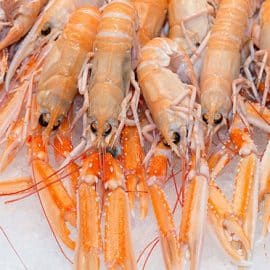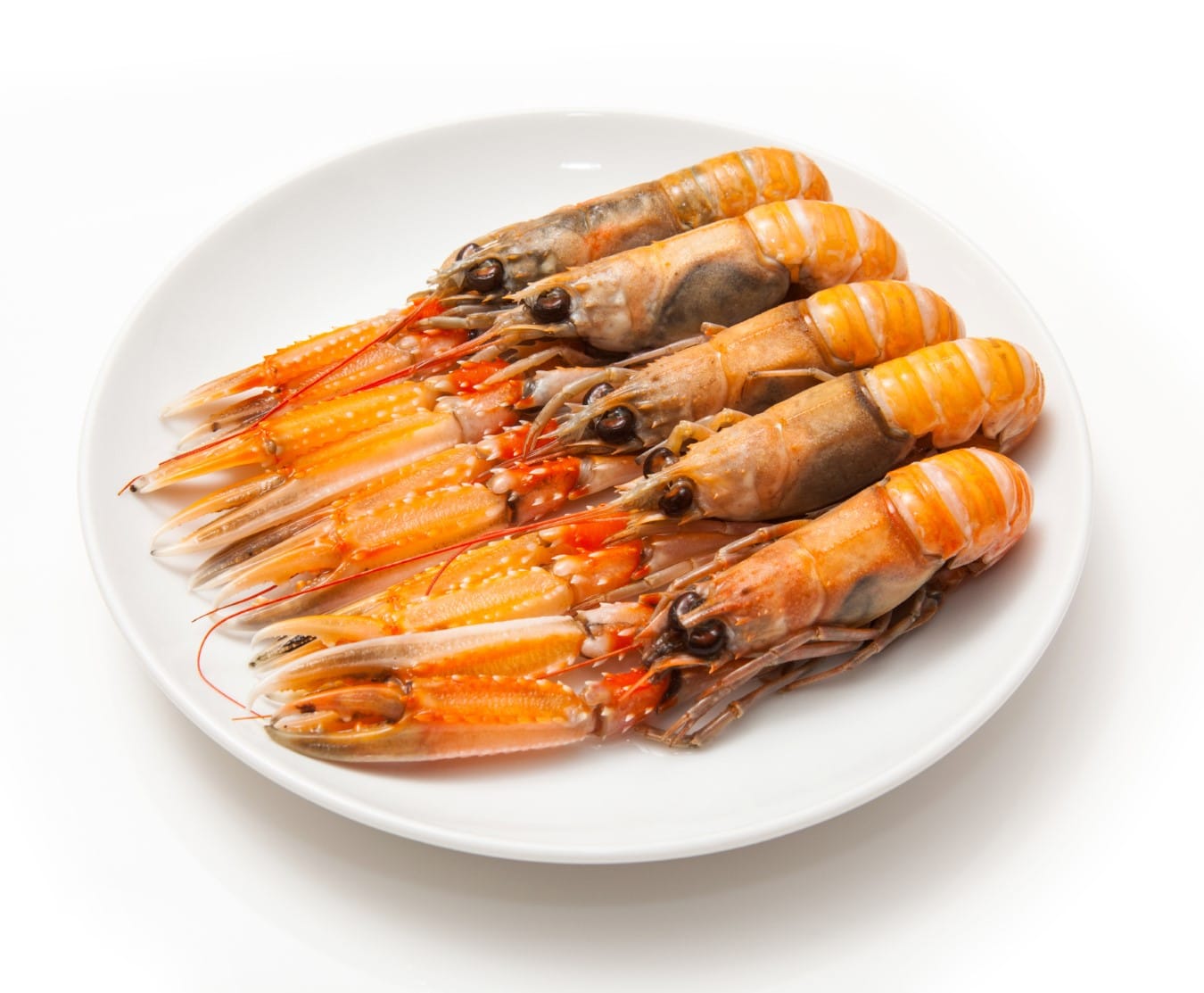
Introduction
Scampi is a shellfish from the crustacean family, commonly known as either dublin bay prawns or lobsters. It has a long and varied history, first harvested centuries ago for food and bait, though it is believed to have originated in the Mediterranean. It is now found worldwide due to successful farming and international transport.
Description
Scampi, also known as langoustine, is a small Norway lobster or Dublin bay prawn native to the coastal waters of Europe. Despite their close relation to shrimp and lobsters, scampi have distinctly different external features. These crustaceans have a paler, orange-brown colouration.
The hardy nature of scampi and their ability to inhabit a wide range of temperatures and depths make them one of the most resilient commercial and subsistence fishing species.
Their sweet taste and chewy texture have made them a succulent staple of Italian, Irish, and French cuisine. All in all, scampi are an essential part of many marine ecosystems around the globe.
Physical Characteristics
Scampi has several taxonomical features which make them easily identifiable. They have a large compound eye and a serrated rostrum (head) that appears triangular.
The scampi body comprises two abdominal segments and a fan-shaped tail flap. They are very slender and often have a slightly curved appearance. The pereiopods are uniformly distributed around the mouth, and the first pair of legs are specialised for feeding.
The carapace of the scampi is generally oval-shaped and smooth. Scampi typically grow up to 4-6 inches in size and weigh up to 7 ounces.
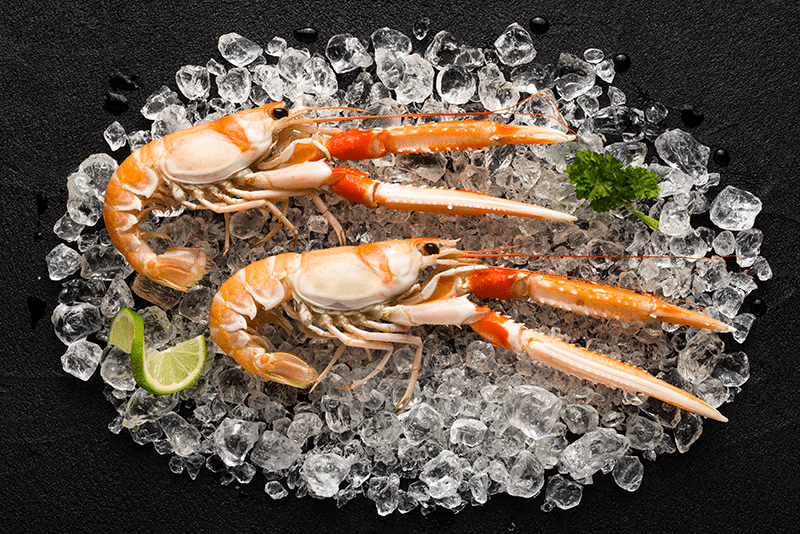
Distribution of Stocks
Scampi is a highly adaptable shrimp-like crustacean found throughout the Northern Hemisphere, from the coasts of the Arctic Ocean to the Mediterranean Sea. They inhabit the western and eastern parts of the North Sea and Pacific Oceans and the east and west coasts of Africa, the British Isles, the Baltic Sea, and the Mediterranean Sea.
Habitat
Scampi typically prefer continental shelf habitats composed of rock, sand, and mud with low sediment levels. They inhabit waters ranging from 0-200 meters in depth, typically favouring shallow coastal areas such as estuaries, salt marshes, mud flats, and the mouths of rivers.
These crustaceans prefer temperatures between 4-32 degrees Celsius and have an affinity for high oxygen levels, salinity between 18 and 34 parts per thousand (ppt), and pH levels between 8 and 8.5. In the north east Atlantic, they usually inhabit depths between 30-150 meters, whilst, in the Mediterranean and Black Seas, depths up to 350 meters are not uncommon.
Scampi Fisheries
Scampi are primarily harvested for human consumption. They are a much sought-after commercial species of marine crustacean that is gathered around the world.
Fishing scampi has become an important industry in many countries, such as Australia, the United States, New Zealand, the Netherlands, Belgium, and the United Kingdom. Various methods are used to catch scampi harvested in many coastal waters, including trawling, dredging, gill nets, longlines and other fishing gear.
Harvesting Practices
Scampi are mainly caught during the warmer months of spring and summer, though some areas may have closed seasons for scampi fishing to ensure populations can replenish. To ensure sustainability and maximum yield, some countries have introduced legislation and regulations to monitor fish stocks and trawling activities.
Wild-caught scampi are often frozen at sea or shipped in containers to processing plants on land, where they can be preserved for long-term storage and transport.
Preserving Scampi Populations
To combat this, the organisations are calling for more sustainable practices for harvesting scampi, such as limits on minimum sizes and seasonal fisheries. These practices can help boost the populations of scampi while preserving the delicate balance of their natural habitats. Other strategies, such as aquaculture, can replenish scampi populations and maintain their long-term viability.
Mitigating Unintended Consequences of Trawling
Trawling can also have unintended consequences, such as destroying seafloor habitats and other unintentional catches. To reduce the impacts of fishing on scampi populations, bycatch can be reduced by setting larger gear with larger meshes, setting gear at safe depths and avoiding certain areas where scampi may be present.
Life Cycle of Scampi
Spawning occurs from late spring to early summer and is temperature-dependent. Scampi typically live up to ten years and undergo a three-stage life cycle.
Females produce between 10,000 and 600,000 eggs per spawning event. In their first stage, eggs are released in deeper, offshore waters while larvae and nauplii drift towards shorelines and settle in shallow coastal areas. They feed on phytoplankton, tiny zooplankton, and bottom-dwelling crustaceans.
In the second stage, these larvae moult and grow into juveniles. Juveniles feed on bottom-dwelling invertebrates and sometimes small fish. In the third stage, these juveniles grow in size and move to deeper, offshore waters. Moulting is continuous throughout the life cycle. Adults feed on larger prey, such as shrimp and small bony fish.

Scampi’s Diet
Scampi are filter feeders and typically consume diatoms, plankton, and detritus as their primary food sources. They are opportunistic feeders consuming whatever food is available in the surrounding environment and can become cannibalistic when food sources become scarce.
Commercial Importance
The succulent tails of scampi are much-prized ingredients in many dishes and have become popular among many chefs due to their delightful texture and taste. This has made the scampi a much sought-after species. Harvesting is rigorously regulated to ensure the sustainable use and health of the species fisheries.
Popularity
The modern version of scampi that we know and love today began in the mid-20th century with the popularisation of lobster scampi. The dish has since become a worldwide phenomenon, peeled tail, readily available in restaurants and as a frozen, ready-made product like the Whitby scampi. It has been further popularised in the 21st century due to the growing trend of healthy and sustainable seafood and its relatively affordable price tag.
Nutritional Values
Scampi is an incredibly nutritious seafood, commonly mistaken for shrimp-like lobsters. A popular superfood, it’s lauded for its numerous essential vitamins, minerals, and fatty acids.
Real scampi boasts a rich protein content, packing all nine essential amino acids in significant amounts. It’s also high in omega-3 fatty acids, which improve brain health and reduce inflammation.
Furthermore, Scampi contains zinc and iron, plus B vitamins such as thiamin, riboflavin, niacin and B6. Its mineral content includes calcium, potassium and selenium, while its fibre content is also notable. All this is packed into a low-fat, low-calorie meal of just four grams of fat and 250 calories per four-ounce serving, so choose to eat scampi more.
Health Benefits of Eating Scampi
Besides its delicious taste and versatility of recipes, scampi can also provide several health benefits. It is a source of high-quality protein and many essential vitamins and minerals our bodies need, such as zinc, phosphorus, vitamin D and omega-3 fatty acids. It is also a low-calorie, low-fat and low-cholesterol food. Therefore, scampi can make a great, nutritious seafood ingredient for anyone looking for healthier protein sources.
Taste and Texture
Scampi typically have a more delicate flavour and are much less fishy than other types of shellfish and seafood. The texture of scampi is very tender and flaky, making it one of the more popular crusted seafood options. Compared to other fish, scampi are low in fat but rich in protein. Scampi meat can vary from firm to soft depending on the species, but it typically has a very tender texture. Compared to other types of fish, such as cod or salmon, scampi has a much milder flavour and less fishy taste.
Culinary Uses of Scampi
Scampi is an edible crustacean, often considered a part of the seafood variety. It has been popularised among different cultures and is primarily prepared and served as a main course or side dish.
The word scampi is a plural for scampo, an Italian word for prawns or langoustines that have been breaded. A scampi in Italy can be any breaded prawn, but a scampi in Britain is always langoustines.
Scampi is part of various recipes, from traditional Italian meals to modern fusion cuisine.
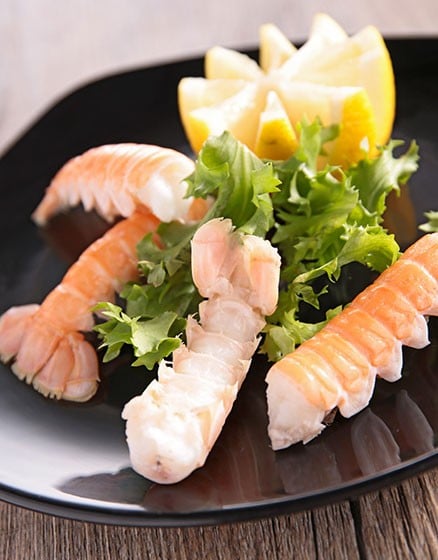
Cooking Methods
Scampi can be cooked differently and is often accompanied by the side dishes and sauces for added flavour. The popular methods for cooking scampi include baking, grilling, sautéing, and deep-frying. It is usually paired with pasta, rice, potatoes, and sauces such as garlic butter, white wine, and other varieties as a main course. It can also be used as a seasoning ingredient in other dishes. Additionally, scampi is also a popular ingredient in soups across different cultures.
When cooking scampi, it is best to cook it quickly to preserve its flavour; this is best done by sautéing or grilling. Some popular recipes that use scampi include scampi alla griglia (grilled scampi in garlic butter) and scampi alla marinara (scampi in a tomato and white wine sauce). Regional recipes for preparing scampi vary all over the world.
Serving Suggestions
Scampi is a very versatile seafood option and can be paired with many different side dishes or used as a main course. Scampi can be fried in butter or rapeseed oil or cooked with various herbs and spices. It can also be used in multiple pasta and soup dishes and can be incorporated into other dishes featuring different types of seafood. Scampi is best served fresh and requires minimal preparation, making it a popular choice among seafood connoisseurs.
Side Dishes
Regarding side dishes, boiled potatoes, lemon wedges, and crusty bread make a classic, simple accompaniment for breaded and battered scampi or any other popular scampi recipe. For a more colourful and flavorful plate, roasted baby potatoes, light green salads, and steamed vegetables such as zucchini, green beans, and broccoli are all good choices.
Creamy sauces, butter, garlic, lemon juice, white wine, and herbs such as parsley and basil can also enhance wholetail scampi flavour. Other flavours that pair well with breaded scampi are anchovies, olives, tomatoes, and artichokes.
Popular Recipes
Garlic butter scampi, also known as garlic roasted scampi, is one of the most iconic recipes. To make this dish, butter is melted in a pan before garlic, scampi and other ingredients like white wine and lemon juice are added. After the scampi has been cooked, parsley and paprika can be used for garnish, and the dish is usually served with a side of pasta, potatoes, or vegetables.
Another popular recipe is scampi with cream sauce. This dish can involve melting butter in a pan and adding garlic, parsley, white wine, cream, and scampi. The sauce is cooked until it thickens and then served with a side dish like pasta or potatoes. Scampi risotto is an excellent variation of the dish, where risotto rice is cooked in white wine, then scampi, parsley, garlic and other spices are added, and the dish is cooked until the rice is soft. This can be served with a lemon wedge.
Grilled scampi skewers are also popular. This involves marinating scampi in garlic, chilli, and olive oil mix, before threading them onto skewers and grilling. The skewers are then served with a side dish of vegetables or potatoes.
Conclusion
Scampi is a popular shellfish appreciated by cultures worldwide for its versatility, affordability and delicious flavours. They are an essential species that provide a delicious and nutritious food source for coastal populations and offer the potential for research and other benefits.
